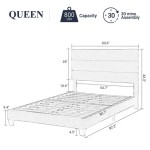How To Do Raised Beds On A Slope
Raised beds offer a solution to uneven terrain, providing level planting areas and improving drainage. On a slope, raised beds become particularly useful, preventing erosion, reducing water runoff, and creating a more manageable gardening space. This article will guide you through the process of creating raised beds on a slope, highlighting the benefits and considerations involved.
Planning and Design
The first step is planning and design. This involves determining the size and shape of your beds, considering factors such as the available space, the type of plants you want to grow, and the slope's angle.
Before embarking on construction, it's crucial to carefully consider the following:
- Slope Angle: Measure the slope's angle using a level or inclinometer. This determines the type of construction and the amount of support needed.
- Sunlight Exposure: Determine the amount of sunlight each potential bed location receives throughout the day. This helps you choose plants that thrive in the specific conditions.
- Access and Walkways: Plan for convenient access to your beds and consider the need for walkways. Narrow walkways can be created between beds, or wider paths can be built along the contours of the slope for easier maintenance.
- Drainage: Ensure your beds have adequate drainage to prevent waterlogging. This can be achieved by creating a slight slope within the beds or using materials that allow water to pass through.
- Materials: Choose materials suitable for your needs and budget. Popular options include wood, stone, concrete blocks, or recycled materials. Consider the durability, aesthetics, and ease of construction for each option.
Construction Techniques for Sloping Terrain
There are several techniques for constructing raised beds on a slope, each with its own advantages and considerations.
1. Terracing
Terracing is a common method for creating level planting areas on a slope. This involves building a series of horizontal platforms or steps, with retaining walls to hold the soil in place. Terracing is suitable for steeper slopes and offers excellent stability. The most common materials for retaining walls include:
- Stone: Durable and visually appealing, but can be expensive to install.
- Timber: Cost-effective and readily available, but requires regular maintenance.
- Concrete Blocks: Durable and affordable, but can create a less natural look.
2. Staggered Beds
Staggered beds are a more natural and less visually disruptive option than terracing. This method involves creating a series of raised beds that step down the slope, following its natural contour. This technique is suitable for gentle slopes and provides good drainage. This method is commonly used for planting rows of vegetables or herbs, with a slight downwards slope for proper drainage.
3. Wall-Mounted Beds
For smaller slopes or creating a vertical garden, wall-mounted beds are an innovative solution. These beds are typically made of wood, metal, or plastic and are attached to a wall, fence, or other structure. They offer a space-saving option for growing herbs, flowers, or smaller vegetables.
Construction Steps
Once you have chosen a construction technique, follow these general steps to build your raised beds:
1. Prepare the Site
Clear the area of any debris, vegetation, or rocks. Carefully mark out the bed location and ensure that it is level before proceeding to construction.
2. Construct the Beds
Build the raised beds according to the chosen method. If using timber, treat the wood with a preservative to extend its lifespan. If using concrete blocks or stone, secure them with mortar or a suitable adhesive.
3. Fill with Soil
Use a high-quality potting mix or a blend of soil, compost, and other amendments. The ideal depth of soil for most raised beds is 12-18 inches. This provides enough space for root growth and ensures adequate drainage.
4. Add Supports
If necessary, add supports to the bed structure. This is especially important for taller beds or those on steeper slopes to prevent movement or collapse. Ensure that the supports are securely anchored to the ground.
5. Plant and Maintain
Once the beds are constructed, plant your chosen crops and provide proper care, including watering, fertilizing, and weeding. Remember to adjust watering techniques based on the slope and drainage of your beds.
Constructing raised beds on a slope can be challenging, but the benefits of a level planting area, erosion control, and increased drainage make it a worthwhile investment. By carefully planning, designing, and constructing your raised beds, you can create a productive and visually appealing gardening space on any slope.

How To Build An Organic Raised Bed On A Sloped Yard Deeply Southern Home

Raised Bed Vegetable Garden On A Slope Gardening Healthy Alyona

Raised Bed Vegetable Garden On A Slope Gardening Healthy Alyona

How To Make Raised Garden Bed In Slope Area Step By Idea For Beginners Gardening Nitha Kitchen

How To Build An Organic Raised Bed On A Sloped Yard Deeply Southern Home

Building A Terraced Garden On Hill Tejas Farm

How To Build Raised Garden Beds On A Slope

How To Build An Organic Raised Bed On A Sloped Yard Deeply Southern Home
Gardening On Uneven Ground Leveling Raised Beds A Way To Garden

How To Build Raised Garden Beds On A Slope







